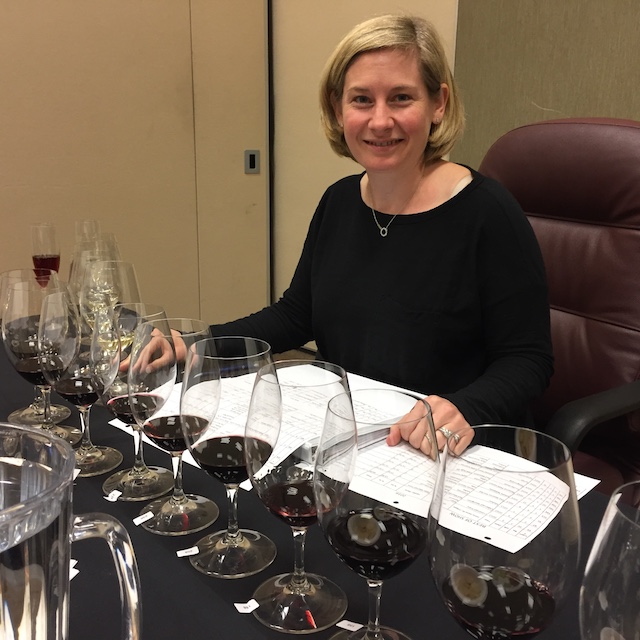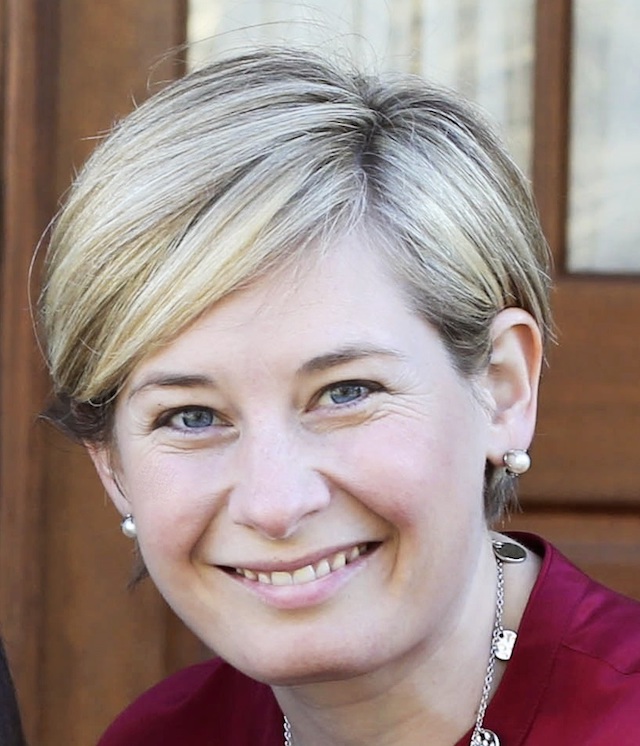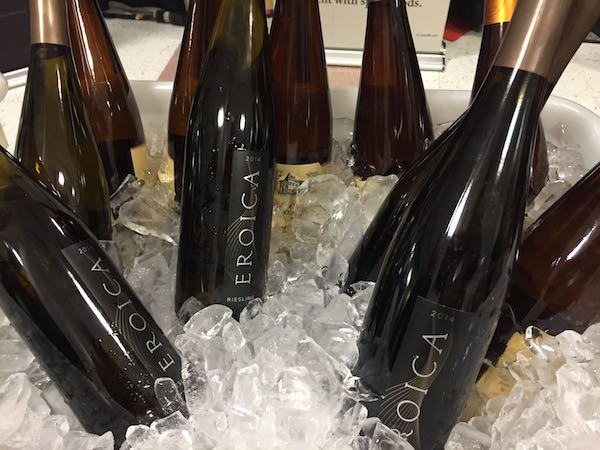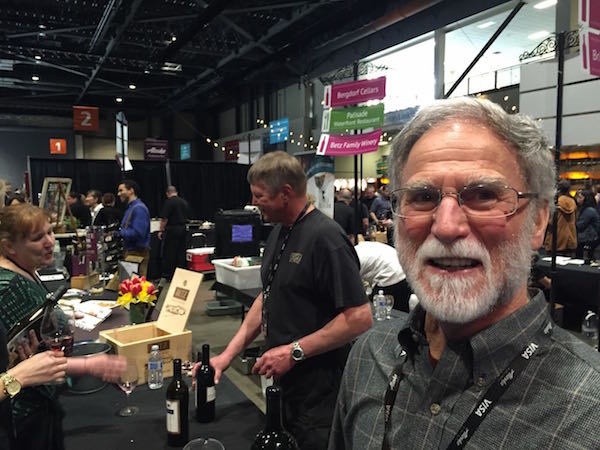
WALLA WALLA, Wash. — Sheri Morano’s aura of approachability and lack of pretentiousness belie the fact that she carries the most prestigious title in her industry – Master of Wine.
“My mother likes to joke that I was weaned on grape juice,” Morano says. “I’m actually not kidding. That is a true family story.”
Morano, who lives in North Carolina, spent last week in Washington state judging the 38th annual Tri-Cities Wine Festival. As an MW, she’s in constant demand across the country as an expert, educator, consultant and judge. Adding to her résumé are two historic footnotes. In 2003, she was only the second woman in the U.S. to qualify for entrance into the Institute of the Masters of Wine. She accomplished that at the age of 28, making her the youngest American woman to do so.
More importantly, she’s also a wife, mother and lover of dogs and cats. She’s rescued many felines in her life. At the time of her engagement, she was an admitted “cat lady” with a handful in her home.
On this unseasonably warm November day in the Columbia Valley, with a tin of Cougar Gold in her luggage, Morano rolled into downtown Walla Walla and checked into Walla Faces Inn sporting a hoodie, a pair of inexpensive jeans and running shoes.
“This is my normal attire,” she chuckled. “MWs? We’re pretty laid back. I do a lot of work from home. Ath-leisure wear is one of the things you will find me in. In my spare time, I am a soccer/lacrosse/basketball/fencing mom, so I have to be ready to go at a moment’s notice sprinting after my child. I prefer to be comfortable over being really serious and dressed up.”
Her least favorite color would be Tar Heel Blue. After all, she’s a proud graduate of Duke University with what rivals along Tobacco Road would view as an unhealthy allegiance to the Blue Devils.
“My true deep love is Duke basketball,” she chortled. “My real claim to fame — not the MW thing — is that I was the person in charge of all student admission for the basketball games my senior year in college. I was what they call ‘the headline monitor’ and that might be what goes on my tombstone.”
And she gleefully confirms that Hall of Fame coach Mike Krzyzewski can talk about wine.
“He loves wine!” she exclaimed. “He really truly loves wine. I know his family and his daughters are big wine lovers, as well. He’s a big red drinker, actually, which is kind of cool. I’ve never actually shared a bottle of wine with Coach K, but that might be up there on the bucket list of things to do some day.”
We recently sat down with Morano near the campus of Whitman College in Walla Walla. Here’s the interview:
[powerpress]
Dukie graduates to Master of Wine

At this point, 13 years after she rose to a place of prominence in the wine world as an MW, the story of her path is one Morano gets asked repeatedly. And yet, it’s not one that she tells by rote. While it may have begun with the family legend of her choosing grape juice over milk as an infant, it started in earnest when she was 16 as part of a high school group spring break trip to Italy with her Latin instructor.
“Our teacher informed our parents that we were going to be legal in Italy to have wine with dinner. That wasn’t a problem,” Morano said. “And I’ll never forget sitting around the table with cheap Italian table wine. It was different depending upon where we were, but what it did was change the dynamics at the table. The enjoyment of the meal was noticeable to me, and I started to pay attention to wine after that, knowing there were all these different types of wine.”
At Duke, she found herself surrounded by wine influences. There was a friend from Sardinia, and she also worked with the office of special events and the office of the university president. Her work with caterers opened up a window into the world of food and wine.
“The day after I turned 21, I went to this wine shop and gourmet store in North Carolina called, A Southern Season,” she said. “I walked into the wine section, and this was the moment I’d been waiting for — my legal wine purchase — and I said, ‘I’ve got to know what these taste like, so I’d like a Chardonnay, a Merlot and a Cab.’
“If I could just figure out these different grape varieties, I would understand more about wine,” she said. “I guess that was the beginning of a beautiful journey for me, wine and my Visa card. It kind of snowballed from there.”
She grew up on Long Island with an interest in Tudor history and considered becoming a professor. Despite graduating magna cum laude from Duke in classical studies, she decided not to attend graduate school, instead moving back to New York where she began working in marketing research.
“I did miss being a student, so I asked myself, ‘What am I interested in learning more about?’ ” she said. “The thing that came to mind was wine.”
Fortunately, she learned of a class being taught in New York City by Mary Ewing-Mulligan, the first woman Master of Wine in the U.S. It wasn’t long after the MW and her husband, Ed McCarthy, produced a recent release of their Wine For Dummies book. At the time, Ewing-Mulligan also was teaching through the Wine & Spirit Education Trust.
“I thought that was really something up my alley,” Morano said. “I sat in the back of the room in the very last seat and almost hid under the table because I was sooo intimidated. Everybody was talking about these things they were getting from the glass (of wine), and I felt like I knew absolutely nothing.”
A couple of sommeliers took Morano under their wing and introduced her to more tasting groups. She soon was working her way through the WSET diploma program.
“There’s nothing more exciting and interesting than studying wine,” she said. “It wasn’t just the wine tasting, but wine to me is the most interdisciplinary subject you can find. It takes everything that I’ve always loved – the history, social, political and economic themes. It’s chemistry. It’s farming. It’s everything.”
She soon realized there were needs for marketing research in the wine industry, too, and teaching opportunities began to open up to her.
“I’ll never forget some of the early mistakes I made in terms of educating people about wine, but that’s another story,” she said with a smile. “About halfway through the diploma program, I realized the Master of Wine was out there as the highest level of certification in the wine trade – along with the Master Sommelier, but I wasn’t interested in restaurant work.”
Her goal was to become the second American woman to earn MW status, which she received in 2003 at the age of 28. Being the youngest ever wasn’t the motivation.
“There had not been a lot of Americans passing for a long time since ’99,” she said. “The pace started to pick up in 2005, I’d say. For me, it was a challenge and something I wanted to do regardless of whether I would be the second female or the youngest.
“I figured that I would be getting older anyway and there would be someone younger and smarter behind me,” she added with a smile. “Age was fleeting, but it came at a time in my life when I felt I could devote the time and attention.”
And the definition of “master” is a misnomer, Morano said. In the vast history and global reach of wine, it’s impossible to be a know-it-all – even just after she passed the final test to become an MW. Of the 354 members worldwide now, she’s one of 40 from the United States.
“In retrospect, the interesting thing for me is to think about that idea as a “master” and what that means,” she said. “In some ways, it was four days when I was probably at my best ever for my tasting and essay writing and my clarity in thinking about wine. But did I know everything? Do I know everything? Absolutely not. The great thing about wine is you have constantly keep learning and pay attention.
“There’s so much emerging in newer regions or areas that are growing that I don’t know everything. To me, the Master of Wine is a way of thinking and approaching wine, not necessarily that I know everything — but I do know where to look it up,” she said. “That’s a good thing. And an exciting a part of that is the community of people. There were a lot of doors that opened up and a lot of connections. It’s not six degrees of separation. It’s really one or two. It’s a closely knit community.”
No stranger to Washington state

Tasting is learning, and she enjoys visiting the Pacific Northwest. This year marks her third time as a judge for the Tri-Cities Wine Festival, the oldest wine competition in Washington at 38 years and counting.
“I just don’t have the opportunity to taste that many Washington state wines living in North Carolina,” she said. “That’s a pretty cool thing to be able to do.”
This year’s judging at the Three Rivers Convention Center in Kennewick generated 426 entries. There were 20 double gold medals, which meant Morano and the rest of her panel agreed they were worthy of a gold medal at a pace of nearly 5 percent. There were 93 gold medals awarded, too.
“If I look back to when I was first here, which I think was in 2002, the overall quality has improved dramatically,” she said. “You could see there was a lot of potential, but the judging panel back then spent a lot of time talking about wine flaws. Brett was a word thrown around quite a lot.
“There were a few times in this go-round were there some noticeable levels of brett, and VA was something I picked up on a number of wines,” she said. “There were a couple where we talked as a panel that (volatile acidity) was higher it should have been.
“But at the same time, I felt the overall quality was extremely high,” she said.
Indeed, there were only 26 entries into the Tri-Cities Wine Festival – six percent of the field – deemed unworthy of a medal. And the rate of gold medals, nearly 26 percent, is extraordinarily high for a professionally judged competition.
“It was interesting to see a focus on certain grape varieties and maybe a couple of others that are lesser known that Washington is not necessarily hanging its hat on them, but there’s potential there,” she said. “Like Malbec. We had some great Carménère, and there were a couple of really nice sparklings and some white blends I was pretty pleased with as well.
“Overall, there’s more than just the big reds,” she added. “But the big reds, quality-wise, that was pretty outstanding.”
East Coast perceptions of Washington

Morano grew up New York and now lives with her family in Chapel Hill, N.C. The view of Washington wines differs depending upon where you are on the East Coast.
“Riesling is something that is associated with Washington state,” she said. “You can’t escape the dominance that Chateau Ste. Michelle Riesling has. We see a tremendous amount of that in terms of availability in the marketplace. They are the world’s No. 1 producer of Riesling.”
On the other hand, Morano said the week judging in the Tri-Cities prompted her to wonder why Washington’s delicious red wines aren’t more widely available in the Carolinas.
“I don’t know. Maybe you guys are just holding onto them here for yourselves and not willing to send them to us?” she said playfully. “It would be nice to see more of those reds in my market because I don’t necessarily think that the connection with say, Washington state Syrah or the red blends, is there in the mind of the consumer. At least not in the Southeast.
“In New York, there’s a slightly different perception because some of the bigger names have a reputation and a reputation with collectors,” she added. “I’ve seen collectors with some of the top names in Washington in their cellars.”
An MW community in NW

There are just four MWs in the Pacific Northwest, and the first was Bob Betz – a product of Chateau Ste. Michelle and founding winemaker of Betz Family Winery in Woodinville. He and Morano go back to the days when he was one of the early denizens of what is now the well-known Woodinville Warehouse District.
“I love Bob, and Bob is just a fantastic guy,” Morano said. “He’s probably one of the nicest guys you could ever meet. For some reason, he reminds me of Sean Connery from Indiana Jones and The Last Crusade. Bob was the person who, after I passed everything but Paper Two of my MW exam, took me on as his mentee. He arranged for me to visit a bunch of different producers out here back when he was in one of those rental storage places making his wine. I tagged along to do racking.
“It’s amazing to look at where Bob is now with his wines and his winery, which is just fantastic,” she added. “Bob has just always been so sincere in his championing of both Washington state and, on the MW side, with candidates, encouraging them to study and succeed. He’s been a really fantastic mentor for a lot of people, especially in that last stage – whether it’s the dissertation or the research paper. He’s a terrific guy.”
Morano also has fond memories of the time she was befriended in South America by Barbara Philip, a graduate of University of British Columbia in Vancouver, who became Western Canada’s first Master of Wine and is her country’s lone female MW. Morano and Philip routinely answer some of the same questions — particularly about the time and money it takes to become an MW. The registration and class fees total more than £10,000, but the expenses surrounding research and study go well beyond that.
“It is definitely not a cheap program, although when you look at any kind of educational program these days there are definitely costs involved,” Morano said. “Back when I did it, the program was not as expensive, and it is a sizable investment now.”
As a result, Morano said the Masters of Wine Institute continues to search for ways to educate, and perhaps warn, candidates of the demands required by the independent study.
“We’re trying to make sure the students getting accepted into the program are ready so that they are spending less time on the program, and therefore less money trying and trying to become MWs,” she said. “For a long time, there were issues with students being on the program for six, seven or eight years. That’s not only an investment of your time and you are probably ticking off your spouse or significant other, but it’s a lot of money as well.”
Research, textbooks and tastings consumed Morano’s time as she pursued her MW.
“One of the things that I felt I had to compensate for was a lack of institutional knowledge,” she said. “I spent a lot of time talking to people and listening to their stories.”
And fortunately, among her tasting groups as she studied for her MW — from 1999 to 2003 — was a panel of consumers with extensive cellars inspired by the early writings of critic Robert Parker.
“Not only did they want to be opening and sharing their wines at this point, they wanted to tell the stories of how they became interested in these wines and collecting these wines,” Morano said. “These were wines from the rise of Parker, and they were early subscribers. The historian and student in me was able to gather a lot of information to compensate for the fact that I was pretty young at the time.”
Mommy Masters of Wine

It was only a handful of years in between completing her MW degree and starting her family. Now, Morano is being joined by other MW mothers.
“There are more women passing than men, so our numbers have definitely jumped,” she said. “It’s really interesting that wine as a career in some ways is mommy-friendly.”
During her pregnancy, she worked as a spokesperson for Wines of France. Her employers embraced her unique status.
“The guy said, ‘Do you think we could send out a press release about that?’ ” she recalled. “I went, ‘Oh my god, this is fantastic.’ ”
She also remembers how the changes involved with motherhood affected her palate.
“There were things I was sensitive to. Alcohol was one of them,” she said. “Corked wine – TCA – actually made me physically ill, which I was really surprised at. Then when I had Peter, I did a lot of travel. I wasn’t ready to leave my son, and they told me, ‘Well, you can bring him with you.’ “So he just traveled as a lap child, and my mom would meet me in various cities to help me take care of Peter. He traveled with me for 2 1/2 years all over the U.S. and to France.”
One of her favorite stories came during a trip to Champagne.
“My poor child,” she started. “We were at a restaurant in Champagne, and the waitress came around to serve the table. We had ordered a bottle of Champagne. She poured for everyone and came back with a spoon and the bottle of Champagne, and she poured some on the spoon. My son was 10 or 11 months old at the time, and she took the spoon and popped it in his mouth.
“I was like, ‘Wow! OK,’ ” she chuckled. “You would get sued immediately in North Carolina for doing that, but in France? A different story. He’d never had bubbles before, so he was a little surprised. She didn’t even ask permission, which kind of cracked me up.”
At this point, Morano – who passed her MW under her maiden name of Sauter — stays involved with the wine industry on many levels. There’s her relationship with Chai Consulting, a partnership with consumer technology Wine Ring, work for marketing agency Strategic Insights, Inc., and her own Triangle Wine School in North Carolina. She’s proud to annually serve as a panel chair for the multi-week International Wine Challenge in London, and there’s also the star-studded TEXSOM International Wine Awards in Dallas where master sommeliers and her fellow MWs fill the seats.
“Again, my goal is to embrace that interdisciplinary side of wine,” she said. “I like to have some fingers in education, writing, judging and also the marketing research and the wine technology company I work with.”
She also meets with wineries and importers, helps fight wine fraud and assists on cellar consulting.
“It’s always interesting to me that people want to know what’s my favorite wine,” she said.
After a recent consumer tasting of French wine, one man’s angle to the question sticks with her.
“ ‘You’re stranded on a deserted island and you can only have one bottle of wine for the rest of your life. What are you going to drink?’ ” Morano recalls. “This has kept me up at night. I don’t know. I don’t play favorites. I can’t have a favorite child — except I only have one child so that’s easy — but I don’t think I can come up with an answer to that.
“He said, ‘Please email me your answer when you come up with it,” she added with a chuckle.
As affable and obliging as she is, that’s an email Morano may never send.
“People want a recommendation,” she said. “They want to know what your ‘house wine’ is, what you are drinking on a regular basis because they want something economical. What’s a good wine to give as a gift?
“I will try to share some of those things, and a lot of times they are things that are widely available,” she added. “I’ve learned when you don’t have an answer, people are fairly disappointed by that.”

Leave a Reply